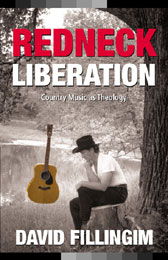

 |
David Filingim. Redneck Liberation: Country Music as Theology. Macon, GA: Mercer University Press, 2003. 170 pages. Reviewed by Steven P. Miller, for the Journal of Southern Religion.
David Fillingim puts a liberation theology gloss on the full spectrum of country music – Hank Williams as well as Garth Brooks. In certain respects, Fillingim attempts to acquire for the creators and constituents of country music the same kind of subaltern recognition scholars have attained for those of jazz and the blues. Such an intriguing blend of Will D. Campbell and James Cone comes naturally to Fillingim, for whom "country music is at its core the music of a marginalized group – the rednecks" (pg. 19). A professor of religion and philosophy (but not, he readily concedes, a musicologist), Fillingim finds within the lyrics of country music such broad, yet sociologically specific theological concerns as hope and dignity, as well as the classic themes of love and fate.
This book works as both a theological meditation and a critical commentary on the state of country music scholarship. (It also provides pages of historical background of use to the non-specialist.) Fillingim's conception of theology is broad, and flows into his Tillichesque understanding of religion as "ultimate concern." Within country music's this-worldly, personalized religiosity, romantic love functions as a "metaphor for ultimate power" (pg. 152). The suffering and cheating songs of country music, like the spirituals and the blues, "are texts of theological liberation because they respond to experiences of oppression and marginalization" (pg. 26). In contrast to white gospel music, Fillingim argues, the "hillbilly humanism" (a useful term borrowed from Steve Goodson) of Hank Williams captures what the author describes as a meaningful irony: recognition of human dignity as normative, yet unattainable.
Unlike Bill C. Malone in his recent book, Don't Get Above Your Raisin': Country Music and the Southern Working Class (2002), Fillingim does not fully address the politically conservative implications of many of the lyrics he analyzes. Although the author is not as uncomfortable with a "false consciousness" paradigm as one might expect, he does engage the politics of country music on its own terms. A compelling chapter on the "honkytonk feminism" of Loretta Lynn (among others) casts her "desire for freedom to fully actualize one's closest relationships" as a country music alternative to a more liberal feminism (pg. 113). In light of his earlier use of blues scholarship, this insight brings to mind an analogy with African-American womanism.
Fillingim has more than an underlying concern with the field of country music studies. He launches a rather pointed attack aimed particularly at Cecelia Tichi, author of High Lonesome: The American Culture of Country Music (1994), who "fails to take seriously country music's social location" (pg. 19). While he is skeptical of attempts to conflate high and low brow cultures (preferring to keep country in the latter camp), he rightly follows the tradition of Malone in eschewing "purist" snobbery and arguing that market forces have shaped the genre from the very start. An acknowledged tension between granting the working class ownership of country music, while presenting country music as partly a market phenomenon, exists throughout this book. His treatment of pop icon extraordinaire Garth Brooks put this tension to the test. Fillingim argues that Brooks blends eschatological hope (e.g., "If Tomorrow Never Comes") with affirmations of passionate living and community ("The Dance"). Still, one might respond, Brooks' celebrity status is based as much on spectacle as it is on affirmations of human decency.
| "Country music's listening audience has broadened to the point where it is no longer the sole interpretave property of the white southern working class." |
Fillingim's largely favorable appraisal of Brooks, the very epitome of suburban country, points to larger questions about the author's use of "redneck" – not as an analytical devise or a cultural signifier, but as an assumed demographic entity. The redneck-country music correlation drifts toward the very type of essentialism that the author otherwise rightly avoids. In commendably addressing the liberationist themes of Brooks and Martina McBride (performer of "Independence Day"), he appears to concede – yet does not grapple with – how hillbilly humanism blends with progressive civil religion and sanitized feminism in their works. Country music's listening audience has broadened to the point where it is no longer the sole interpretative property of the white southern working class.
These qualms aside, Fillingim should be applauded for elucidating with sensitivity (and without condescension) the theological stuff of heartbreaks and honkytonks. Moreover, the book is filled with lively prose, which the author undoubtedly took pleasure in composing. Fillingim manages to connect Hank Williams with the Dixie Chicks, while zinging a few country music scholars along the way.
Steven P. Miller, Vanderbilt University
© 1998-2004 by The Journal of Southern Religion. All rights reserved. ISSN 1094-5234